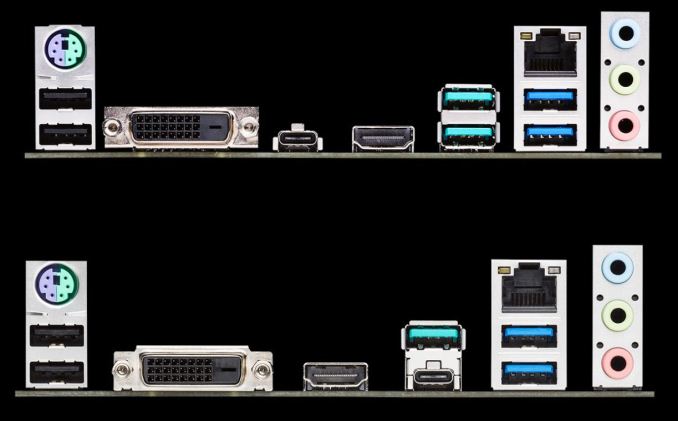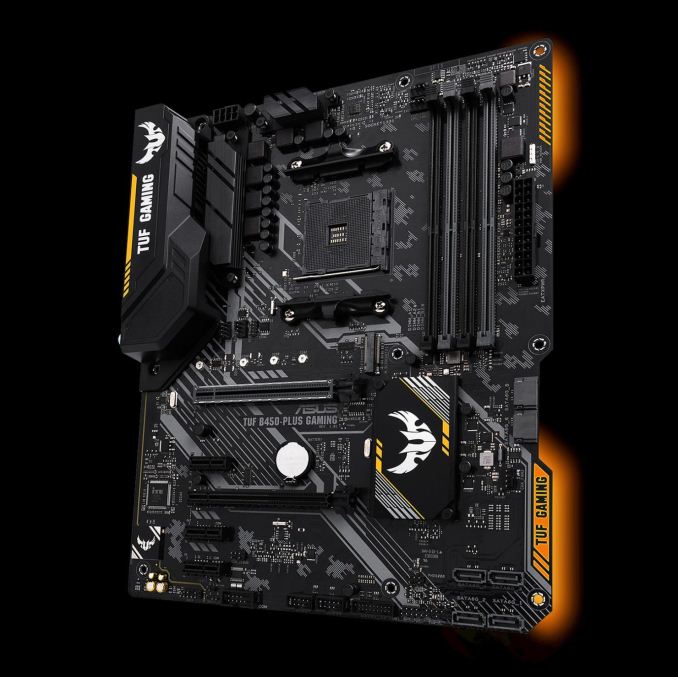Analyzing B450 for AMD Ryzen: A Quick Look at 25+ Motherboards
by Gavin Bonshor on July 31, 2018 8:00 AM ESTASUS TUF B450-Plus Gaming and
ASUS TUF B450M-Plus Gaming
Back in October last year, I went to an ASUS meeting at the UK HQ to talk about the upcoming Intel Z370 Motherboard launch where I was introduced to the ASUS TUF Z370-Pro Gaming and Z370-Plus Gaming. The TUF branding from ASUS is synonymous with boards such as the ASUS TUF X99 Sabertooth, so when ASUS HQ officials explained to me that the TUF (The Ultimate Force) brand was being re-arranged from a range with rugged looksand a longer than usual five year warranty to a more budget-focused gaming range which sits below the Strix range, it was somewhat nauseating. Nonetheless, ASUS states that they feel this is the best way forward for the brand, along with collaborations with memory and cooling manufacturers to be part of the TUF system.
With the launch of the new B450 chipset, ASUS has let loose two new TUF Gaming branded boards through the full-sized ATX TUF B450-Plus and the smaller TUF B450M-Plus.

The ASUS TUF B450M-Plus (left) and ASUS TUF B450-Plus (right) motherboards
Aesthetically speaking, both TUF B450 models have a near identical style with a customizable RGB section at the bottom right-hand corner, with both boards having a TUF branded chipset heatsink, dark grey metallic power delivery heatsinks and a rear panel cover which is black. The PCB also has a black and grey contrasting design printed on and the heatsinks have a yellow accented style which falls in line with the new TUF color scheme.
Both the TUF B450-Plus and B450M-Plus have very similar feature sets and component choices, with the main differences between the two coming through the form factor, which then naturally limits the PCIe 3.0 x1 capabilities of the B450M-Plus due to conforming to microATX standards. What both boards do share is two full-length PCIe slots with the top slot operating at PCIe 3.0 x16 and the second full-length slot operating at PCIe 2.0 x4 across both boards. The B450-Plus has a total of three PCIe 2.0 x1 slots, whereas the TUF B450M-Plus has a solitary x1 slot available.
Focusing on the power, ASUS looks to have equipped the same six phase Digi+ power delivery across both models, with the phases operating in 4+2 mode. Both boards have a metallic looking heatsink across the CPU section of the power delivery, while the SoC section does not. Power to the CPU comes from an 8-pin ATX 12 V input and power to the rest of the motherboard and chipset comes through a 24-pin ATX power input.
Both the TUF B450-Plus and B450M-Plus share the same storage options which primarily consists of six SATA ports with both models having four straight angled connectors, and two right-angled connectors emanating from the board. Users looking to make use of RAID storage configurations will be pleased to know both boards can accommodate RAID 0, 1 and 10 arrays. There is also a single PCIe 3.0 x4 M.2 slot featured on both models with support for drives up to a size of M.2 22110 (22 x 110 mm) and allows for both PCIe and SATA varieties of SSD to be used.
With the latest AM4 chipsets offering better memory capabilities out of the box thanks to a wave of firmware updates, both the TUF B450 boards take advantage of DDR4-3200 support from the get-go, with both having four memory slots giving the pairing a total combined memory capacity of up to 64 GB. The TUF boards also support ECC memory, but ASUS does state this support varies depending on the CPU.
In terms of cooling options, the ATX sized TUF B450-Plus has a total of five 4-pin fan headers dotted around the board which are split between one header to the CPU fan, three specifically for case fans and a single header dedicated to an AIO CPU cooler pump. The size limitation strikes the smaller microATX TUF B450M-Plus as only three 4-pin headers are present with a single one for the CPU fan and two for case fans. Both boards can have their USB real estate capabilities pushed beyond what’s on the rear panel with a further two USB 3.1 5 Gbps and four USB 2.0 ports being available through internal USB headers.

The ASUS TUF B450-Plus rear panel (top) compared to the ASUS TUF B450-M Plus rear panel (bottom)
Directing the attention to the rear panel, both boards have near indistinguishable layouts and connection choice with both boards having a PS/2 keyboard and mouse combo port, a single DVI-D and HDMI port, three 3.5mm audio jacks to make use of the Realtek ALC887-VD2 audio codec. On top of this is a single LAN port which is controlled by a Realtek RTL8111H Gigabit networking chip. The only differences come through the USB connections with the TUF B450-Plus having two USB 3.1 10 Gbps Type-A ports, a single USB 3.1 5 Gbps Type-C, two USB 3.1 5 Gbps Type-A ports and two regular USB 2.0 ports. The smaller ASUS TUF B450M-Plus has a single USB 3.1 10 Gbps Type-A port, a single USB 3.1 5 Gbps Type-C port, two USB 3.1 5 Gbps Type-A ports and two standard USB 2.0 ports.
Both of the TUF B450 Plus models have a unique styling with the black and white contrasting PCB, with yellow accents across the board and there is RGB expansion capability through a single ASUS Aura Sync-enabled RGB header on both for users looking to add their own flair and style. Both boards are near identical in features and with the B450-Plus Gaming set to retail for $119.99 and the smaller B450M-Plus Gaming coming in at a slightly cheaper price of $99.99, both look to offer value to users without scrimping too much on feature set.



_thumb.jpg)
_thumb.jpg)
_thumb.jpg)
_thumb.jpg)
_thumb.jpg)
_thumb.jpg)
_thumb.jpg)
_thumb.jpg)
_thumb.jpg)
_thumb.jpg)
_thumb.jpg)
_thumb.jpg)








62 Comments
View All Comments
bi0logic - Tuesday, July 31, 2018 - link
It looks like the price link to the "TUF B450-Plus Gaming" is going to an amazon search for "ASRock B450M Pro4"eastcoast_pete - Tuesday, July 31, 2018 - link
Thanks Gavin, I know this is a lot of information to go through and present. I would love to see a follow-up on these questions:1. Especially for these compact boards, any problems with stock processor heat sinks blocking DIMM slots, i.e. do DIMMs with heat spreaders still fit with a Wraith or Spire cooler, respectively?
2. I have my eye on the Aorus Pro WiFi or something similar, but am wary of the placement of the WiFi antenna connectors right next to two of the USB 3 connectors. I frequently use 3-4 USB 3 devices at the same time frequently, and am wary of the USB 3 - WiFi interference with that placement. Any chance Gigabyte could state if/that they got that taken care of?
Thanks!
Also, still looking forward to your Ryzen 2200/2400 GPU overclock chapter on that duo. Any chance we'll see it soon?
sonofgodfrey - Tuesday, July 31, 2018 - link
Second to last table is labeled X470 Motherboards.PingSpike - Tuesday, July 31, 2018 - link
It looks like the ASUS ROG STRIX B450-F GAMING inherits some of the layout features of the (much more expensive) x470 Crosshair 7 in that it steals some of the CPU lanes to get a second full PCI-e 3.0 M.2 slot. Then 8x goes to PCI-e 16 1, the remaining 4x to PCI-e 16 2 and finally a chipset PCI-e 2.0On the surface, this seems like it has totally ignored the bifrucation limitations that supposedly are inherent to the B450 chipset.
In other words, I thought you couldn't get that on this chipset.
Dragonstongue - Tuesday, July 31, 2018 - link
well at least the pricing is "more inline" with the pricing they should be, newer boards, better componentes that actually save the maker a bit of coin per board made, so they keep the same "launch price" is acceptable in my books coming from gen 1 (I so hate the naming AMD used for Ryzen 1xxx and 2xxx needless confusion for nothing)x3xx to x4xx same concept, reduced price to produce so they save some money, but the vast majority of vendors used these "savings" to cram more disco light show RGB on the boards to jack the price up some instead.
seems at least with the B4xx boards the vendors took a "better" approach beyond a few more "premium" boards which rightfully have an increased price (justifiable, maybe, but I myself have zero need of RGB and would only buy a more expensive board that offered them at the increased price if they were WORTH it as far as just overall better then lower cost boards, sadly, there seems to be little difference in more "premium" beyond a butt load of extra RGB little better in VRM etc which are much more useful and required IMO)
they could almost have a market for the premium boards RGB free, so pay a bit less for people like me who do not want all the RGB crud but still get the increased premium sound/VRM/BIOS etc ^.^
WasHopingForAnHonestReview - Wednesday, August 1, 2018 - link
Nice review. Good work.Im amazed that almost every comment is a nitpick. Rough life, Ian.
Flappergast - Wednesday, August 1, 2018 - link
Nice overview on the last page. I’m looking for mITX WiFi - nice to see some good boardsSakkura - Wednesday, August 1, 2018 - link
As documented by Buildzoid, the Asrock B450 Pro4 does not have the claimed 6+3-phase VRM. It is a pure 3+3-phase. Same probably applies for the B450M Pro4.https://youtu.be/yWAwOH-egFs?t=2104
JohanPirlouit - Wednesday, August 1, 2018 - link
Hi everyone,Am I the only one to see that on the AMD picture:
- CPU: 2x SATA 3Gbps
- Chipset: 6x SATA 3Gbps
What do AMD talks about: SATA "3" (known as "6Gbps") or SATA 3Gbps (aka SATA II)?
Sakkura - Wednesday, August 1, 2018 - link
They mean SATA3 = SATA 6Gbps. Annoying that we keep running into these easily confused naming schemes (see also: USB 3.1 Gen1 and Gen2). At least SATA is getting old enough that we should soon be able to just drop the version number (unlike USB 2.0 there's really no reason to make modern hardware with SATA2).